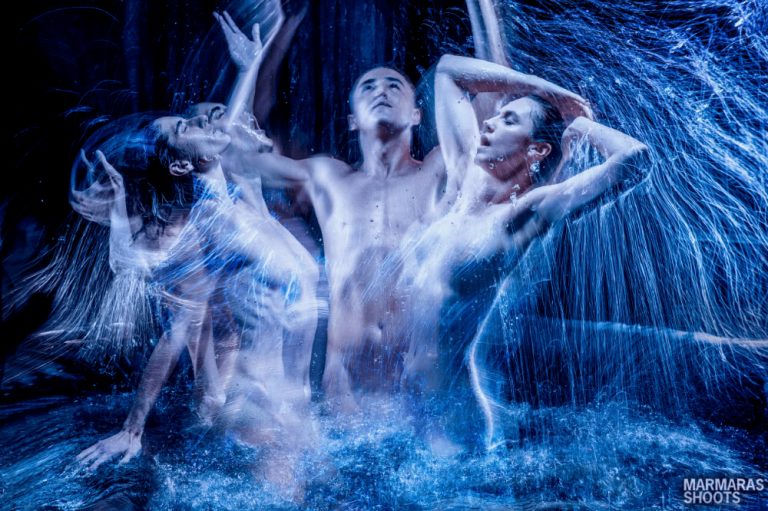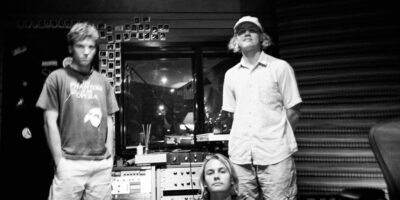As Sydney gears up for Mardi Gras, the team behind Redline Productions are working feverously to bring Mary Zimmerman’s epic play Metamorphoses to the Old Fitz. Directed by Dino Dimitriadis, it is a sprawling, lyrical collection of Greek myths with a huge list of characters, earning it a rep for being uniquely difficult to produce.
And yet, it isn’t the first time Dimitriadis has staged the work, having directed the production at Erskineville’s PACT theatre in 2012. He describes being struck “by the vastness of the piece and its enormous worlds” as well as the “ideas it was exploring; these primal human qualities that we have in the face of extraordinary and large change.”
In spite of a firm belief that he would not return to Zimmerman’s play, plans to mount a show for the 40th anniversary of Mardi Gras were made and the play spoke to him yet again.
Many of the qualities originally attracting Dimitriadis remained alluring, and he thought more about its potential suitability to theatre. He describes the work as “a piece of scaffolding that you can use and hang off.” Indeed, the script itself offers few directions and only sparse splatterings of esoteric dialogue.
The opportunity to revisit the work after so many years has also allowed him to approach it with renewed vigour and experience, and the result is a show that is highly ambitious. “It’s definitely the biggest production I’ve ever put on the stage and the most technically demanding. It’s a very big design, not just the set but the lighting and the sound that’s being composed; it’s an enormous cast, who are playing multiple characters.”
There’s a complex relationship between identity and the body, but also on a very basic level the body as the primary site of experience in the world.
Further, for Dimitriadis, the ethereal dialogue and technical challenges provide an answer to the text-based naturalism often found in Sydney. He recalls being “interested in creating a piece of theatre that was theatrical; that reminded us that theatre could be magic.”
However, one of the main reasons for remounting Metamorphoses was the potential for a queer reading. Immediately, the “switching or subversion” of the characters’ genders offers different perspectives and “ [allows for] representation of identities that we don’t often get to see on the stage in these sorts of stories.”
While subversion of gender is an important part of the production, this reading manifests in a plethora of other ways. Firstly, given it was a predominantly queer team working on the piece, Dimitriadis believes the lived experiences of the cast and crew have “threaded [their] way into the production.”
Further, Dimitriadis describes queer theatre as creating a “liminal space that allows the history of queer identity to meet the present of queer identity.” For that reason, the production contains a number of visual references, both overt and subtle, to queer history.
On a thematic level, he also draws comparisons between the very concept of metamorphosis, around which the play centres. “In a broad sense I’m interested in the idea of nothing being fixed, of everything being in a constant state of questioning and I think the positioning of the play in this fragmented sense very much allows for that.”
As a director, Dimitriadis has dissolved the narration into a “multi-voice chorus”, has actors shifting characters at a moment’s notice and has done everything possible to “dissolve traditional ideas of character” in an effort to explore the notion of changing identity. The production also draws on the rich tapestry of queer theatre conventions; “camp, genderfucking, parody, sexual explicitness, non-linearity, irony, exaggeration and surrealism” to illustrate the queer capacity to “create and recreate ourselves.”
Another major way Dimitriadis seeks to explore queer experiences is through the human body. “For me, a very big idea of queer theatre is an absolute celebration of the body. For me, bodies are really important; the first word of the play is ‘bodies’ and I think it sets the tone not just for the play but for what I’m doing with it.” The audience can therefore expect bodies in all their glory, often nude and always unadulterated. With a stark design, these bodies become “the primary set” for the work.
When asked what it is about the body that is so ripe for exploration in queer theatre, he is quick to answer. “There’s a complex relationship between identity and the body, but also on a very basic level the body as the primary site of experience in the world.” Queer theatre, he says, empowers us to interrogate our perceptions of the body and the world, as well as the “remnants of modernity” that cause us to categorise and label human experiences along biological lines.
Water is one of those things you add to the list of things never to work with, alongside children and animals.
He still breaks conventions even where the text is layered with cultural and historical assumptions about sex and gender. However, he concedes, very few elements of the play are forecast to be smooth. The scope of the piece is huge, while the Old Fitz is one of the city’s smallest theatres. And one area in which they have remained faithful to the original staging is the inclusion of a pool in which much of the play’s action occurs. The technical challenges this poses are immense, with Dimitriadis acknowledging, “water is one of those things you add to the list of things never to work with, alongside children and animals.”
Even so, the team are regarding the boundaries as a blessing, and regardless of the outcome, Dino is embracing the challenge. “We have an obsession with shiny polish in this city [when it comes to] art, but art can have a few rough edges to it and not be compromised.”
See Metamorphoses at the The Old Fritz in Woolloomooloo from now until Saturday March 10.


































